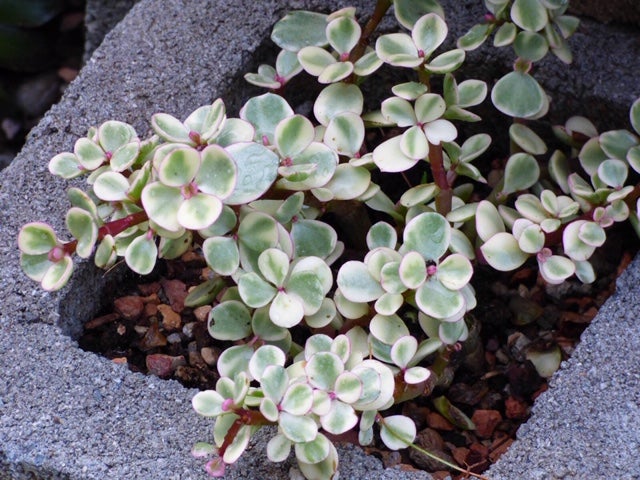Rainbow Bush Info: How To Grow A Variegated Elephant Bush


Also known as variegated elephant bush or rainbow portulacaria plant, rainbow elephant bush (Portulacaria afra 'Variegata') is a shrubby succulent with mahogany stems and fleshy, green and creamy white foliage. Clusters of small, lavender-pink blooms may appear at branch tips. A cultivar with solid-colored leaves is also available and known simply as elephant bush.
Rainbow Bush Info
The elephant bush, native to Africa, is so named because elephants love to eat it. Rainbow portulacaria plant is a warm-weather plant, suitable for growing in USDA plant hardiness zones 10 and 11. For this reason, it is usually grown as an indoor plant. In its natural environment, variegated elephant bush can reach heights of up to 20 feet (6 m.). However, this slow-growing plant is usually limited to 10 feet (3 m.) or less in the home garden. You can control the size even further by growing rainbow elephant bush in a small container.
Rainbow Bush Care
Place variegated elephant bush in indirect sunlight. Intense light can scorch the leaves and cause them to drop from the plant. The plant should be warm and protected from drafts. Be sure the container has adequate drain holes. Overwatering and poorly drained soil are the most common causes of death for rainbow portulacaria plants. An unglazed pot is preferable because it allows excess moisture to evaporate. Fill the container with a potting soil for cacti and succulents, or use a combination of half regular potting soil and half sand, vermiculite, or other gritty material. Water the plant regularly from April to October, but never overwater. In general, it’s best to withhold water while the plant is dormant during the winter months, although you can water very sparingly if the leaves look shriveled. Fertilize rainbow elephant bush in late winter or early spring, using an indoor plant fertilizer diluted to half strength.
Gardening tips, videos, info and more delivered right to your inbox!
Sign up for the Gardening Know How newsletter today and receive a free copy of our e-book "How to Grow Delicious Tomatoes".

A Credentialed Garden Writer, Mary H. Dyer was with Gardening Know How in the very beginning, publishing articles as early as 2007.
-
 Looking For Plants To Give You The Soft And Fuzzies? Try These 5 Fuzzy Leaf Plant Options
Looking For Plants To Give You The Soft And Fuzzies? Try These 5 Fuzzy Leaf Plant OptionsLovers of texture, drama, silver foliage and tactile plants will adore these special sensory garden additions. These fuzzy leaf plant options will leave you all aglow
By Susan Albert
-
 Get Ready For A Summer Of Hummers! Grow These Full Sun Hummingbird Plants and Flowers
Get Ready For A Summer Of Hummers! Grow These Full Sun Hummingbird Plants and FlowersIf you’re lucky enough to enjoy a sunny backyard, make sure you are maxing out on your pollinator opportunities and grow these full sun hummingbird plants and flowers
By Tonya Barnett
